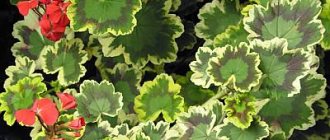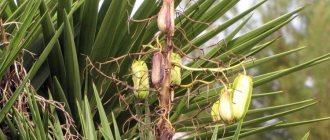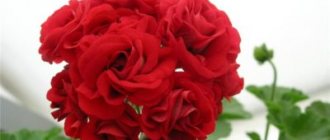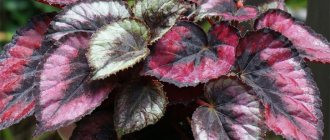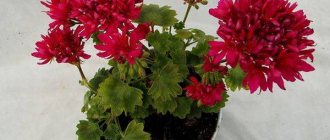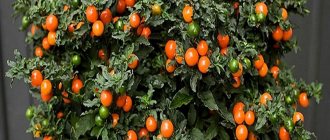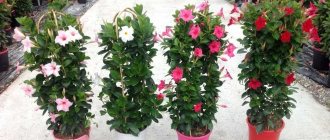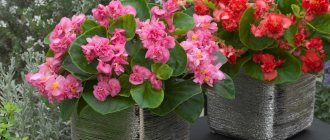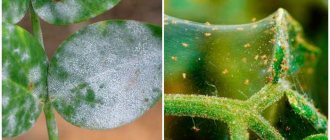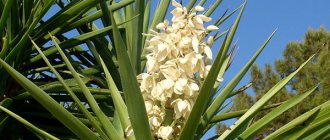Botanical description
The closest relative of ivy (or ivy-leaved) pelargonium is geranium . Specimens of this plant were first discovered in South Africa and brought to Europe at the end of the 17th century. Despite the fact that pelargonium and geranium are often mistaken for one flower with a synonymous name, these are two completely different plants, although they come from the same family - Geraniaceae.
This species got its name due to its characteristic smell, curly shape and leaves that seemed flattened. Ever-standing stems reaching a length of 70-100 centimeters are a wonderful decoration for such a majestic flower.
The price of the plant is not high, because Because of its unpretentiousness, it became very popular among the people and soon began to grow in almost every home. Its cost ranges from 70 rubles and above.
Description of appearance and features
This plant is characterized by:
- Quite long stems, capable of reaching 100 centimeters in length.
- Massive top, striking variety of shades. And during the flowering period, the bush is covered with abundant flowers, similar to the crown of a king, decorated with colored constellations. Each individual “crown” has about 50 flowers.
- Color, which can be varied - red, pink, white, blue, lilac, burgundy, etc.
- The fluffiness of flowers having more than six roundish petals.
The peculiarity of ivy-shaped pelargonium is that, due to its unpretentiousness, this flower is honored not only to decorate gardens and external window sills , but also to bloom on wide stands in the house.
Varieties of ivy-leaved pelargonium with photos and names
Thanks to the work of breeders, there are about 70 varieties of hanging pelargoniums. These include plants with plain or variegated petals, decorated with strokes or a border. Flowers can have a varying number of petals, and some bushes also have elegant leaves with pinkish or yellow edges. Typically, these varieties have leaf blades that are more rigid.
Summer rain
The length of the shoots of this variety of ampelous geranium is about 80-100 cm. They have green leaves with a smooth surface. Their size reaches 8 cm. Each umbrella includes from 5 to 8 simple flowers. Flowering continues from late spring until October. This variety is unpretentious and can be grown both at home and outside in the summer. In the garden, the bush can serve as a decoration for hanging flowerpots and containers or grow in a flower bed as a ground cover.
For healthy growth, the bushes will need good lighting and regular but moderate watering. Excessive soil and air moisture will lead to rot. If the variety is grown from seeds, a peat-sand mixture is used for sowing them, but an adult bush will develop better in heavier clay soil, characteristic of its native places. In winter, it is recommended to keep geranium in a cool corner, where it stays at about 15 degrees, but not less than 10 degrees.
Crystal Queen
This varietal group of ivy-leaved pelargonium is distinguished by strong branching and forms strong and spreading bushes. Their shoots withstand strong winds. Their length can vary from 30 cm to 1.5 m. The stems are abundantly covered with foliage, and during the flowering period - with snow-white, red or pink inflorescences. One can contain up to 9 large flowers. The time of their appearance is in the summer, lasting from May to September. In order for geraniums to bloom longer, it is necessary to regularly remove faded flowers from them. This plant can be kept on both southern and western windows. Varieties reproduce well by seeds
Tuscany
This geranium combines several varieties with different flower colors. The bush grows to half a meter in height, and its flowering lasts from late spring to late autumn. Semi-double flowers with rounded petals form large spherical inflorescences. “Tuscany” is characterized by increased cold resistance - even at zero temperatures the plant does not die. At home, in winter it is kept at 10 degrees, temporarily reducing the volume of watering.
Common varieties of ivy geranium and photos
The most common types of ivy pelargonium are:
Pink Rosebud
Pink Rosebud or, as they are also called, “rosebuds” are a type of pelargonium with double petals, reminiscent of a rose. The huge inflorescences are capable of long-term flowering and differ from roses in their lack of aroma. They are not particularly different in cultivation from their relatives.
Pac Mexica Nealit (Mexico Neolithic)
A very unusual decorative variety. Valued for its double and dense pink-lilac inflorescences, from the center of which a white pattern radiates. With good lighting, the flower seems to emit neon light. The flowering period begins in mid-May and ends at the end of September.
Features of ivy-leaved pelargonium
Under natural conditions, ivy-leaved pelargonium (Pelargonium peltatum) grows in South African territory. Today, numerous varieties and hybrids of the crop, bred by breeders, are in demand among flower growers in many countries, on various continents. Such plants, planted in hanging pots and used as decoration for balconies, loggias, and window sills, look simply magnificent.
Growing pelargonium in personal plots has proven itself well. This representative of geranium crops feels great if its vines hang along a vertical plane, or when they form a flowering, dense carpet, softly settling along a flat area.
Ivy-leaved pelargonium got its name from its five-lobed, leathery, smooth leaves. They resemble the leaves of another climbing plant - ivy.
Pelargonium shoots are quite strong. As they grow, they have the ability to cling to ledges of rocky slopes and climb upward, ensuring the dispersal of seeds. Numerous varieties of ivy-leaved pelargonium, suitable for growing at home, are characterized by the presence of stems whose length is up to 1 m.
The culture has umbellate inflorescences, uniting 6 - 15 flowers. Their formation occurs in the axillary recesses of leaves, which have a green or variegated color. Varietal forms of the plant may have simple flowers with a uniform color. Terry ivy-leaved pelargoniums with petals decorated with contrasting spots, stripes, and a clear border look very impressive.
How to plant and root a plant?
Each flower and plant needs its own conditions for planting and rooting. Ivy pelargonium is no exception. Planting at home is not difficult; this can be done in two ways: seeds and cuttings.
If you choose the path through seeds, then be patient and be prepared to go through a very painstaking and difficult road. Usually this option is chosen by more experienced gardeners. Seeds are planted from February to early April.
- The seeds are immersed in the soil to a depth of 1 centimeter.
- Then moisten the soil well with a spray bottle.
- The box with seedlings is removed to a warm and well-lit place.
- The temperature should not fall below 22 degrees Celsius and exceed 25 degrees.
- The seedlings are planted in permanent soil 3-4 weeks after planting (depending on the seedling).
You should know! Ivy pelargonium grown from seeds blooms much more abundantly and colorfully.
Cuttings are much easier, especially if you have somewhere to get those cuttings. You need to do this work in early March.
Select large cuttings, without defects or damage, cut them and let them dry for 24 hours.- Carefully treat the sections with charcoal powder. It dries and disinfects the plant.
- Plant cuttings in the treated soil at a distance of 2-3 centimeters, thoroughly compact the soil.
- A month after this procedure, the seedlings can be planted on permanent soil.
For comfortable growth of ivy-shaped pelargonium, not only proper planting is necessary, but also location , lighting, and soil. This is what we will talk about now.
Flower location and lighting
After purchasing ivy-shaped pelargonium, the first thing you need to do is choose a location for the flower. Since this type of plant is very thermophilic, it will prefer to be located in the sun. The ideal option would be a window sill on the south side of the house, and when planting outside, unshaded areas.
Soil condition
The roots of pelargonium are very delicate, so the selection of soil must be treated with special care. The soil should be loose, nutritious and moisture-absorbing. The soil should not be allowed to dry out too much; this can lead to a host of unnecessary diseases. But excessive humidity is also unacceptable.
Attention! If you water frequently, the plant may get sick and die.
additional nutritional elements during the period of active development and flowering . It is better not to use fertilizers in winter. These supplements should be applied once every two weeks. You should not resort to organic fertilizers.
Rules for planting and care
As practice shows, planting and caring for ivy-leaved pelargonium will not cause problems if the recommendations of specialists are correctly followed. Below are tips regarding growing crops, the study of which will certainly be useful for novice florists.
What conditions are considered optimal for the plant?
Pelargonium likes bright sunlight. It is able to grow quickly and develop in good light conditions. At the same time, the bush tolerates drought without problems. Pelargonium, planted in a balcony box, flowerpot, or flowerbed near the house, demonstrates magnificent flowering in the warm season at temperatures of + 20 ... + 25 ° C.
A plant that is provided with sufficient watering in the heat will not lose its beauty and will delight with magnificent flowering for a long time. A culture that has undergone a hardening procedure calmly tolerates short-term cold snaps. However, negative temperatures are contraindicated for her.
A plant grown in a flowerpot should be replanted every 2 years in the spring. In addition, such an event will be justified when the container becomes too small for the bush.
Soil quality requirements
When choosing soil for planting a crop, you should give preference to moisture-absorbing, loose, nutritious soil.
Planting pelargonium in soil with neutral, weak or medium acidity has proven to work well. When planting a plant in a flowerpot, you should purchase a special substrate in advance from a flower shop.
When deciding how to root pelargonium, you can prepare your own soil mixture. It should contain: peat, humus, sand, turf, leaf soil in equal parts.
Preparing a flowerpot and drainage
It is worth refusing to provide the plant with an overly large pot. It would be preferable to plant the crop in a container whose dimensions will exceed the size of the pelargonium roots by an amount equal to the thickness of a finger (1 - 1.5 cm). You can also place several bushes in one flowerpot or balcony box. Thus, the plants will constantly form new buds, which will immediately affect their splendor and beauty.
Since pelargonium is considered a mountain “resident”, it needs drainage. For this purpose, pieces of expanded clay should be placed at the bottom of the flowerpot.
Periodic feeding
The crop requires periodic fertilizing. The bushes begin to actively develop in March, and their flowering lasts until the beginning of autumn. Plants growing in flowerpots need to be fed weekly with mineral supplements. But organic fertilizer is not welcome.
Experienced gardeners warn against using nitrogen-containing nutrient solutions too often. Oversaturation of the soil with this component causes rapid growth of stems and leaves, but has a negative effect on flowering. In a plant overfed with nitrogen, the formation of buds is inhibited altogether or occurs in significantly smaller quantities.
In order for the stems of pelargonium to become covered with lush inflorescences, you need to give preference to potassium and phosphorus fertilizers. The use of magnesium sulfate has worked well. Experienced florists often use a solution of iodine (1 drop) in water (1 liter) to stimulate flowering. Approximately 50 ml of this product is applied to one bush at a time.
Pelargonium outdoors in summer
The zonal ivy-leaved pelargonium, which is constantly in the room, feels excellent. At the same time, plants placed outside the window into the garden at the beginning of the warm season experience stress. In order for the acclimatization of a crop to be as painless as possible, it must be gradually accustomed to growing in conditions with constant changes in temperature, humidity, and light.
In May, after the frost season has passed, the bushes are assigned to permanent places where they will grow throughout the summer. In autumn, when temperatures drop to + 10 ... + 15 ° C, they should be taken indoors again. It is noteworthy that the formation of pelargonium and its flowering will occur faster if there is a plant nearby with petals of contrasting colors.
Organization of wintering pelargonium
In order for ampelous pelargonium to overwinter indoors in the best possible way, it will need to be placed in a bright, cool, dry place. The recommended temperature range is + 7 ... + 15 ° C. At this time, watering is reduced. The plant needs enough soil moisture to prevent the death of the root system. Irrigation of leaves and stems is prohibited. It is advisable to complete fertilizing within 30 days.
When studying information on how to prune pelargonium on the eve of wintering, you need to take into account that experienced florists prefer to remove all shoots, and dig the plant itself out of the flowerpot along with a lump of soil and identify it in a transparent cellophane bag. A bush preserved in this way can be placed on an insulated balcony or loggia.
Home care
To ensure that ivy pelargonium does not lose its flowers and has a lush crown, it must be pruned every year.
During pruning, its shoots are either completely removed or shortened to 2-3 nodes. In addition to pruning, the plant also regularly requires removal of dry leaves and stems. Dry leaves and stems should not be plucked; scissors must be used to do this to avoid rotting and infection of the flower.If possible, cut areas can be treated with crushed activated carbon.
- The optimal temperature for flowering ivy-shaped pelargonium is 20-25 degrees, but the plant feels great even on hotter days, does not wither and continues to bloom.
- In summer, it is best to keep such a flower outside, placing it in the open air and allowing it to enjoy the rays of the sun. You should not immediately place the flower under the scorching sun; first you need to let it acclimatize.
Diseases and pests
After summer has arrived and the plant has moved to the open air, its health becomes susceptible to attacks by various pests and diseases. What to do and how to avoid such problems?
First you need to understand what caused the “blow” to the plant. Most often, infection of a flower manifests itself in lethargy and dullness of the leaves, brown and yellow spots , and dryness. With such symptoms, you should think about the health of the plant and be wary.
The most common diseases of ivy pelargonium are:
- Botrytis fungus.
This is usually caused by excessive humidity. The fungus appears as brown spots and the formation of gray fluff on the leaves. Rapid spread leads to leaf fall. With such a fungus, you should cut off all infected areas and transplant the flower into another pot, spraying it with fungicides.
Root system rot.
Rot is also caused by excess moisture. Subsequently, the rot spreads throughout the stem from bottom to top. This infection is characterized by brown and black colors. To avoid further spread of rot, the soil should be replaced with a looser one so that water cannot stagnate in it.- Bacterial diseases.
This type of disease does not lead to the death of the crop, but it does cause a serious blow. The stem partially darkens and withers. Treatment consists of frequent spraying and weeding. - Ticks.
Appear as yellow specks on the leaves and stem. The reasons for such a visit may be dry air and high temperatures. Such lesions are treated with soap and mineral oil. If the process is too advanced, then chemicals such as Ditox, Molniya and others can come to the rescue. - Aphid.
Aphids can be identified by special signs: the leaves of the flower begin to curl. Such sheets must be cut off and the rest washed with soapy water. Also, the preparations “Tobacco dust”, “Iskra” and others save from aphids. - Thrips.
It appears in the form of growths on the back side of the leaf. Leads to deformation of leaves and the appearance of yellow spots. The drugs “Biotlik”, “Aktara”, etc. help prevent the appearance of thrips.
Why doesn't it bloom?
When buying ivy-leaved pelargonium in a store, they are often assured that it blooms profusely and pleases the eye every season. Believing the sellers' words, you bring the flower home and soon notice that the flower does not bloom, but only climbs up.
One of the reasons may be incorrect soil composition. Sandy soil is good for growing this type of plant. Pelargonium will not bloom in peat soil due to poor air permeability. If your ivy pelargonium is in peat soil, then it should be replanted. If the passage of moisture and air is poor, the root system can rot and lead to the loss of the flower.
Another reason could be improper placement of the plant. If a flower lacks abundant light and sunlight, then what kind of flowering can we even talk about? Help pelargonium “live” and give it some warmth.
Propagation by cuttings
Ivy pelargonium, like all other types of this crop, has long been loved by the people. It is not surprising, because this is an unpretentious and fairly easy-to-care plant. And how many colors there are! Everyone wanted a “piece” of such beauty for themselves.
Propagation by cuttings is one of the simplest methods of dividing a beautiful plant. To carry out this procedure you need to know the following:
Note! The best time for propagation by cuttings is spring.
- The first stage of growing ivy-shaped pelargonium from cuttings is cutting long shoots into shorter ones (5-10 centimeters). Leaves do not need to be removed. We make two cuts on the cutting: under the bud and above it.
- After all this, place the cuttings in an opaque container. Pour water no more than 5 centimeters and change it regularly (once every 2-3 days). The container should be opaque, because roots love darkness very much.
- We place the cuttings on the windowsill and wait for the roots to appear (from 5 to 15 days).
- Here you need to draw attention to the fact that it is better to plant ivy-shaped pelargonium not in the ground, but in a special tablet saturated with microelements and consisting of peat. Such tablets are designed for better rooting of the plant.
- After all the work done, the plant can be transplanted into permanent soil.
In the video we will clearly see the cutting process:
Taking into account all the nuances of this type of plant, monitoring its health and not forgetting about watering, you can thoroughly enjoy the flowering of ivy-shaped pelargonium . The flower will delight you with its bright inflorescences, making guests of your home admire this wondrous beauty day after day.
On our website you will find photos, descriptions and secrets of growing numerous species and varieties of pelargonium. Among them, the most common are: Bold, Red Pandora, Mildfield Rose, Richard Hudson, Norland, Salmon, Denise, Prince Gustav, Stellar and Lady Gertrude.
Propagation of amelian geranium
It is not difficult to propagate ivy-leaved pelargonium - to do this, the plant bush is divided or cuttings, or flower seeds are used. The last method is considered the longest.
Cuttings
To obtain a new bush, cuttings are usually used. They are cut from stems left over from spring or autumn pruning. Spring ones taken before mid-March take root the fastest. The length of the cuttings should be up to 10 cm, each should have 1-2 internodes and up to 3 leaves. The foliage is removed from the lower internodes. Buds will also need to be removed if they are already on the shoots. The cut areas must be dusted with charcoal for disinfection. If the cuttings are already woody, they are kept in the shade for about an hour, allowing the cut to dry.
The prepared cuttings are placed in an opaque container with water, where activated carbon has been added (1 tablet per glass) or immediately planted in a substrate or peat tablet, lightly spraying the soil. If the cutting has wilted, you can cover it with a jar or transparent bag. In such conditions, roots should form in a couple of weeks. If this procedure is carried out in winter, the time required for root formation is at least doubled. In addition, young plants will need additional lighting.
After planting, the cuttings are kept in the shade for about 5 days, and then moved to a lighter and cooler corner, where the temperature is about 16 degrees. When, after transplantation, the plants begin to form fresh foliage, rooting can be considered successful.
AMPEL PELARGONIA (GERANIUM). VIDEO LESSON No. 2 (reproduction).
Growing from seeds
Growing ampelous pelargonium from seeds is more difficult than from cuttings. Seeds usually take about 1-2 weeks to germinate, but sometimes you have to wait longer. Scarification helps speed up the process: the dense shell of the seeds is rubbed with sandpaper. After this, the seeds are immersed in a solution of a growth stimulant or potassium permanganate for 20 minutes, and then soaked in water. The prepared seed is sown in a shallow container, leaving 5 cm between the seeds. Then the container is covered with film or glass and placed in a bright and warm place. As the soil dries, it is sprayed so as not to wash it away.
With the appearance of sprouts, the shelter begins to be gradually opened, increasing the ventilation time daily. When the seedlings form 2-3 leaves, the film is removed completely, and young pelargoniums dive into their own pots (no more than 10 cm in diameter and up to 14 cm in depth). A drainage layer must be laid at the bottom of the container. A couple of weeks after picking, fertilizing is carried out. When the bushes reach a height of 15 cm, they need to be pinched to stimulate the growth of side shoots.
